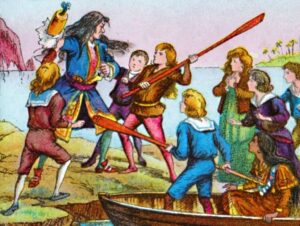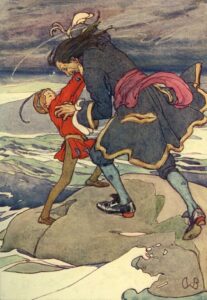The tale of a magical boy who forever stays young, Peter Pan, has within it a lesson that is essential for a functioning society, family, and individual. It isn’t just a story of adventure and redemption; it’s a coded message for men and boys – and those who care about men and boys. A new live-action Disney rehash of the tale told by author J.M. Barrie is due for release, and, perhaps unsurprisingly, a liberty or two has been taken with the original play.
Clickbait media has reveled in either criticizing the race of the actors in the film or criticizing those who criticize the race of the actors. Essentially, the skin color of any of the characters is irrelevant and a distraction from the major literary – and cultural – crime that has occurred. The actual meaning of the story has been removed by making some of the Lost Boys girls.
In the teaser trailer, Wendy – upon meeting the raggedy troupe – remarks, “you’re not all boys,” which elicits the defiant response, “So?” Surely this is insignificant. But, no, it is the very heart of the story and the element that makes it such an important piece of a cultural more that has, in fact, spanned millennia and likely every nation or tribe that has ever existed.
But let’s back up a second.
Peter Pan is the very definition of a boy – archetypal if you will. He doesn’t want to grow up or assume responsibility and, through magic, he becomes untethered from the rationality that forces maturity on us as we age.

(Photo by The Print Collector/Getty Images)
The villain of the story is, of course, Captain Hook, a pirate who lives by his own rules and is chased -eventually to his doom – by a crocodile with a ticking clock inside its belly. Now here’s the rub: Captain Hook is Peter Pan if he continues down the path of immaturity.
Peter mocks the captain. He teases and tests him at every opportunity but, deep down, this is his future if he remains King of the Lost Boys. He is forever chased by the archetypal dragon (in this case, also representing the passage of time and inevitable death as signified by the incessant tick-tocking of the clock). What could be more boyish and representative of delayed maturity than playing the pirate rogue with your friends, with no rules but those you make yourself, and a life of adventure on the high seas?
Captain Hook’s crew are the Lost Boys, and he is their Peter Pan. If nothing else, this is a cautionary tale that the protagonist barely glimpses despite the multitude of clues presented (losing his shadow, for example)
So why are female Lost Boys a problem? Exhibit A: Have you ever met a 13-year-old boy? Boys are known to be less mature than girls during their formative years. This phenomenon is well-documented and a valid proposition across cultures and ethnicity. There’s even a name for it: Neural Pruning. As explained by the psychology and neuroscience website Exploringyourmind.com:
“This process of optimizing brain connectivity consists of eliminating the connections (synapses) seldom used, leaving instead those they do use frequently. Myelination nourishes the latter to strengthen and optimize their performance.
“This process starts earlier in girls, having its first onset between the ages of ten and 12, and continuing until the age of 19 or even beyond. In boys, neurological pruning begins around the age of 15.”
Although this was finally proved via MRI studies by Newcastle University in collaboration with the US National Institutes of Health (NIH), it is a position that has been accepted for thousands of years all around the world.

Peter Pan and Captain Hook (Photo by Bridgeman via Getty Images)
So, what does this mean for Peter Pan? Well, the Lost Boys (for which we should really say: the prolonged and oft-fought-against maturity of the adolescent male) are captured by Captain Hook and placed in real danger. They become hostages of the future self that refuses to recognize society needs its boys to become men.
He finally saves the Lost Boys and Wendy by confronting Hook (his future self and, to some extent, his understanding of mortality). It is a battle that has been long in coming and one that Peter must win: He has to defeat the eternally adolescent (and scared) pirate captain that is the potential sum of his own immature choices.
You see, Peter Pan is a Lost Boy – the King of them, in fact. He is representative of all young boys, who themselves are “lost” – whether that is in their fantasy realms or their refusal to become productive members of a society that, despite what they may think, absolutely needs them to fulfill their role, whatever that may be.
By making Lost Boys into girls, this new version of Peter Pan ignores the reality that this is a predominantly male problem. It removes from our present cultural smorgasbord a lesson that boys and adolescents need first to recognize and then relate to themselves. How can we expect a dragon to be slain if we do not understand that a dragon exists? Yes, it is a story, and stories can be told in many different ways, but to remove the true inherent value of a story – the moral and societal puzzle that must be solved in order for our world to function in a way that avoids as much chaos and misery as possible – does all of us, men and boys, women and girls, a huge disservice. Disney, in pandering to woke sensibilities, has torn the heart out of a valuable cultural lesson and fundamentally weakened a profound story.
Hey, Disney, do the world a favor: It’s time to stop assuming we need a safe space where we are all cookie-cutter replicas of each other and put up a big sign saying, “Here there be dragons!”
Do you have an opinion about this article? We’d love to hear it! If you send your comments to [email protected], we might even publish your edited remarks in our new feature, LN Readers Speak Out. Remember to include the title of the article along with your name, city, and state.
Please respect our republishing guidelines. Republication permission does not equal site endorsement. Click here.

